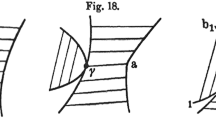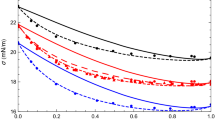Abstract
In this study, we present a modified interfacial parameter to reduce the vacuum phenomenon for the triple junction in the ternary Cahn–Hilliard (CH) equation. The triple junction is the point where three phases meet each other. In the ternary system, we interpret a position as occupied by a phase, if the concentration of the phase is larger than one-half. Therefore, it is well known that there exists a vacuum phenomenon: none of the phases exist, that is, all the concentrations are less than one-half. In the proposed method, we introduce a phase-dependent interfacial coefficient that has a constant value away from the triple junction and smaller values in the neighborhood of the triple junction, which effectively reduces the vacuum region. To validate the superiority of the proposed approach, we present the characteristic numerical experiments for the ternary system. The computational results confirm the superior performance of the proposed method over the conventional method.








Similar content being viewed by others
References
Shi, J., Cheng, L., Cao, R., Jia, Z., Liu, G.: Phase-field simulation of imbibition for the matrix-fracture of tight oil reservoirs considering temperature change. Water 13(7), 1004 (2021)
Park, J.M., Anderson, P.D.: A ternary model for double-emulsion formation in a capillary microfluidic device. Lab Chip 12, 2672–2677 (2012)
Fu, Y., Zhao, S., Bai, L., Jin, Y., Cheng, Y.: Numerical study of double emulsion formation in microchannels by a ternary Lattice Boltzmann method. Chem. Eng. Sci. 146, 126–134 (2016)
Azarmanesh, M., Farhadi, M., Azizian, P.: Double emulsion formation through hierarchical flow-focusing microchannel. Phys. Fluid 28, 032005 (2016)
Wang, N., Semprebon, C., Liu, H., Zhang, C., Kusumaatmaja, H.: Modelling double emulsion formation in planar flow-focusing microchannels. J. Fluid Mech. 895, A22 (2002)
Wörner, M., Samkhaniani, N., Cai, X., Wu, Y., Majumdar, A., Marschall, H., Frohnapfel, B., Deutschmann, O.: Spreading and rebound dynamics of sub-millimetre urea-water-solution droplets impinging on substrates of varying wettability. Appl. Math. Model 95, 53–73 (2021)
Shin, J., Yang, J., Lee, C., Kim, J.: The Navier–Stokes–Cahn–Hilliard model with a high-order polynomial free energy. Acta Mech. 231, 2425–2437 (2020)
Soligo, G., Roccon, A., Soldati, A.: Mass-conservation-improved phase field methods for turbulent multiphase flow simulation. Acta Mech. 230, 683–696 (2019)
Lee, H.G., Kim, J.: An efficient numerical method for simulating multiphase flows using a diffuse interface model. Physica A 423, 33–50 (2015)
Liang, H., Shi, B.C., Chai, Z.H.: Lattice Boltzmann modeling of three-phase incompressible flows. Phys. Rev. E 93, 013308 (2016)
Liang, H., Xu, J., Chen, J., Chai, Z., Shi, B.: Lattice Boltzmann modeling of wall-bounded ternary fluid flows. Appl. Math. Model 73, 487–513 (2019)
Fakhari, A., Bolster, D.: Diffuse interface modeling of three-phase contact line dynamics on curved boundaries: a lattice Boltzmann model for large density and viscosity ratios. J. Comput. Phys. 334, 620–638 (2017)
Li, H.-L., Liu, H.-R., Ding, H.: A fully 3D simulation of fluid-structure interaction with dynamic wetting and contact angle hysteresis. J. Comput. Phys. 420(1), 109709 (2020)
Zhang, Q., Wang, X.P.: Phase field modeling and simulation of three-phase flow on solid surfaces. J. Comput. Phys. 319, 79–107 (2016)
Zhou, S., Xie, Y.M.: Numerical simulation of three-dimensional multicomponent Cahn–Hilliard systems. Int. J. Mech. Sci. 198, 106349 (2021)
Haghani-Hassan-Abadi, R., Fakhari, A., Rahimian, M.H.: Numerical simulation of three-component multiphase flows at high density and viscosity ratios using lattice Boltzmann methods. Phys. Rev. E 97, 033312 (2018)
Semprebon, C., Krüger, T., Kusumaatmaja, H.: Ternary free-energy lattice Boltzmann model with tunable surface tensions and contact angels. Phys. Rev. E 93, 033305 (2016)
Yi, S.: A phase-field method for the numerical simulation of rigid particulate in two-phase flows. Fluid Dyn. Res. 52, 015512 (2020)
Jeong, D., Yang, J., Kim, J.: A practical and efficient numerical method for the Cahn–Hilliard equation in complex domains. Commun. Nonlinear Sci. Numer. Simul. 73, 217–228 (2019)
Liang, H., Zhang, C., Du, R., Wei, Y.: Lattice Boltzmann method for fractional Cahn–Hilliard equation. Commun. Nonlinear Sci. Numer. Simul. 91, 105443 (2020)
Yang, J., Kim, J.: An unconditionally stable second-order accurate method for systems of Cahn–Hilliard equations. Commun. Nonlinear Sci. Numer. Simul. 87, 105276 (2020)
Rohde, C., von Wolff, L.: A ternary Cahn–Hilliard–Navier–Stokes model for two-phase flow with precipitation and dissolution. Math. Model Methods Appl. Sci. 31(1), 1–35 (2021)
Haghani-Hassan-Abadi, R., Rahimian, M.H.: Axisymmetric lattice Boltzmann model for simulation of ternary fluid flows. Acta Mech. 231, 2323–2334 (2020)
Yang, J., Kim, J.: Linear, second-order accurate, and energy stable scheme for a ternary Cahn–Hilliard model by using Lagrange multiplier approach. Acta Appl. Math. 172, 10 (2021)
Li, Y., Choi, J.-I., Kim, J.: Multi-component Cahn–Hilliard system with different boundary conditions in complex domains. J. Comput. Phys. 323, 1–16 (2016)
Huang, Z., Lin, G., Ardekani, A.M.: A consistent and conservative model and its scheme for \(N\)-phase-\(M\)-component incompressible flows. J. Comput. Phys. 434, 110229 (2021)
Zhu, G., Chen, H., Li, A., Sun, S., Yao, J.: Fully discrete energy stable scheme for a phase-field moving contact line model with variable densities and viscosities. Appl. Math. Model 83, 614–639 (2020)
Ren, H., Zhuang, X., Trung, N.T., Rabczuk, T.: Nonlocal operator method for the Cahn–Hilliard phase field model. Commun. Nonlinear Sci. Numer. Simul. 96, 105687 (2021)
Lee, H.G., Shin, J., Lee, J.-Y.: A high-order convex splitting method for a non-additive Cahn–Hilliard energy functional. Mathematics 7(12), 1242 (2019)
Boyer, F., Lapuerta, C.: Study of a three component Cahn–Hilliard flow model. ESAIM Math. Model Numer. Anal. 40(4), 653–687 (2006)
Trottenberg, U., Oosterlee, C., Schüller, A.: Multigrid. Academic Press, London (2001)
Kim, J., Kang, K., Lowengrub, J.: Conservative multigrid methods for Cahn–Hilliard fluids. J. Comput. Phys. 193(2), 511–543 (2004)
Kim, J.: Phase field computations for ternary fluid flows. Comput. Methods Appl. Mech. Eng. 196, 4779–4788 (2007)
Lee, H.G., Kim, J.: Regularized Dirac delta functions for phase field models. Int. J. Numer. Methods Eng. 91, 269–288 (2012)
Chorin, A.J.: A numerical method for solving incompressible viscous flow problems. J. Comput. Phys. 2, 12–26 (1967)
Yang, J., Kim, J.: A phase-field model and its efficient numerical method for two-phase flows on arbitrarily curved surfaces in 3D space. Comput. Methods Appl. Mech. Eng. 372, 113382 (2020)
Acknowledgements
The corresponding author (J. S. Kim) was supported by the National Research Foundation (NRF), Korea, under Project BK21 FOUR. The authors thank the reviewers for their constructive comments regarding the revision of this article.
Author information
Authors and Affiliations
Corresponding author
Additional information
Publisher's Note
Springer Nature remains neutral with regard to jurisdictional claims in published maps and institutional affiliations.
Rights and permissions
About this article
Cite this article
Yang, J., Lee, C. & Kim, J. Reduction in vacuum phenomenon for the triple junction in the ternary Cahn–Hilliard model. Acta Mech 232, 4485–4495 (2021). https://doi.org/10.1007/s00707-021-03072-8
Received:
Revised:
Accepted:
Published:
Issue Date:
DOI: https://doi.org/10.1007/s00707-021-03072-8




